Q What happened to the permanently coupled two business cars, the “Virginia” and the “Carolina,” that the Southern Railway provided for its president and chairman?— Bob Sewell, Marysville, Wash. A The Virginia (NS 1) and the Carolina (NS 2) have been paired since they were built in 1928. Pullman originally constructed them for Southern Railway. […]
Era: 2000 - Present
CSX Transportation Chicago Division, Plymouth Subdivision in HO scale

Name: CSX Plymouth Subdivision Layout designer: Chip Cole Scale: HO (1:87.1) Size: 30 x 60 feet Locale: southeast Michigan Era: 2009 to present Style: linear, around the walls Mainline run: 188 feet Mininimum radius: 30″ (18″ in Livonia Industrial Park) Minimum turnout: no. 6 Maximum grade: 2.5 percent Originally appeared in the Great Model Railroads […]
A railroad’s railroad – BNSF’s O gauge layout
BNSF Ry. is using O gauge trains to share its story with the public. […]
A railroad’s railroad – BNSF’s O gauge layout
BNSF Ry. is using O gauge trains to share its story with the public. […]
The N scale Oakville sub

Name: The Oakville Sub Layout designer: Jim Reising Scale: N (1:160) Size: 26′-6″ x 52′-0″ Prototype: Union Pacific and BNSF Ry. Locale: Ex-Southern Pacific line between Bakersfield and Tehachapi, Calif. Style: walk-in, partial multilevel Era: present day Mainline run: 222 feet Minimum radius: 24″ Minimum turnout: no. 7 Maximum grade: 2 percent Originally appeared in […]
Norfolk & Portsmouth Belt Line
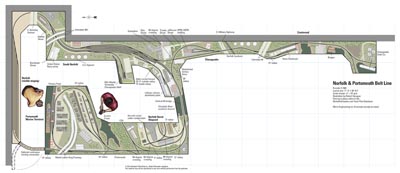
Name: Norfolk & PortsmouthBelt Line Layout designer: Bob Sprague Scale: N (1:160) Size: 11′-3″ x 13′-10″ with 30″ x 14′-81⁄2″ shelf Prototype: NPBL Locale: southeastern Virginia (Hampton Roads) Era: present day Style: shelf with peninsula Branchline run: 30 feet plus 15 feet Minimum radius: 18″ (9″ on some industrial tracks) Minimum turnout: no. 6 Maximum […]
Denver, Front Range & Western

Name: Denver, Front Range & WesternLayout designer: Doug TagsoldScale: HO (1: 87.1)Size: 25 x 40 feetPrototype: Union PacificLocale: Denver west into the Rocky MountainsStyle: double-deck linear walkaroundEra: 2005Mainline run: 450 feetMinimum radius: 30″Minimum turnout: no. 6Maximum grade: 2.5 percent Originally appeared in the April 2012 issue of Model Railroader. Click on the link to download […]
Big Island Rail
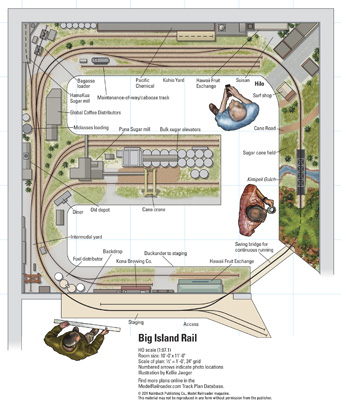
Name: Big Island Rail Corp. Layout designer: Joesph Kreiss Scale: HO (1:87.1) Size: 10 x 11 feet Prototype: Hawaii Consolidated Ry. Locale: Hawaii Era: present day Style: walk-in Minimum radius: 18″ Minimum turnout: no. 6 Maximum grade: 1 percent Originally appeared in the January 2012 issue of Model Railroader. Click on the link to download […]
Large scale Miami Rail Service Co
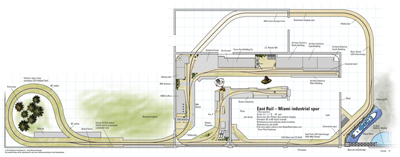
Name: Miami Rail Service Co. Layout designer: Bob Springs Scale: 1:29 Size: 20 x 36 feet, plus outdoor staging Prototype: CSX industrial spurs Locale: Miami Era: present day Style: around-the-walls shelf Mainline run: 200 feet (loop) Minimum radius: 66 inches Minimum turnout: no. 6 (main), no. 4 (one spur) Grade: none Originally appeared Great Model […]
Utah Belt 2006
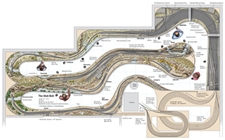
Track plan at a glance Name: Utah Belt Layout designer: Eric Brooman Scale: HO (1:87.1) Size: 22′-8″ x 39′-6″ Prototype: freelanced Period: the present Style: linear walkaround Mainline run: 173 feet Minimum radius: 39″ Minimum turnout: no. 6 Maximum grade: 1.5 percent Originally appeared in the 2006 issue of Great Model Railroads. Click here to […]
Utah Belt
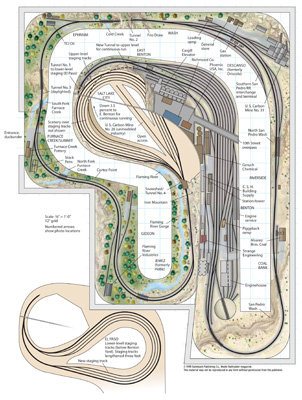
Track plan at a glance Layout designer: Eric Brooman Name: Utah Belt Scale: HO (1:87.1) Size:17 ‘-7″ x 23 Prototype: free-lanced Period: the present Style: linear walkaround Mainline run: 173 feet Minimum radius: 39″ Minimum turnout: no. 6 Maximum grade: 1.5 percent Originally appeared in Great Model Railroads 1997 and in the February 1998 issue […]
Cabooses on Norfolk Southern

Norfolk Southern and some other railroads use cabooses or riding platforms to protect shove moves. NS Q I know Class I railroads haven’t used cabooses for some years. On a Roanoke, Va., webcam, though, I have seen Norfolk Southern use a caboose on many occasions. The trains do not look like work trains, but rather […]
